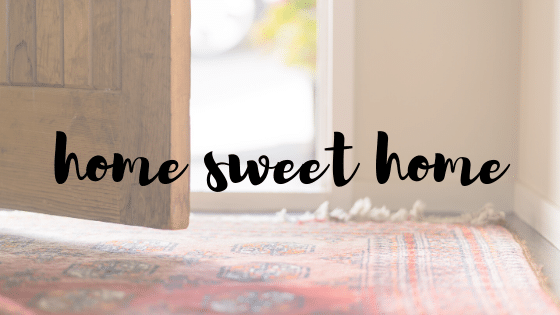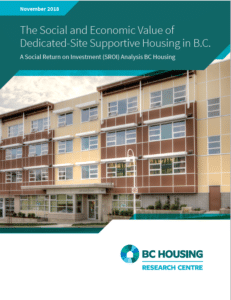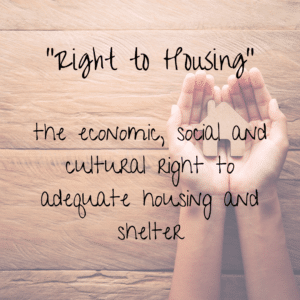Supportive housing in BC is gaining more recognition as a key way to prevent homelessness. In the social service field, it is considered best practice in a laundry list of possible interventions when supporting individuals with barriers. However, to the average person, “supportive housing” is barely recognized at all. In this blog post we are going to tell you all about supportive housing—what it is, how it works, and why it’s the foundation of Work 2 Live, our program for youth experiencing homelessness.
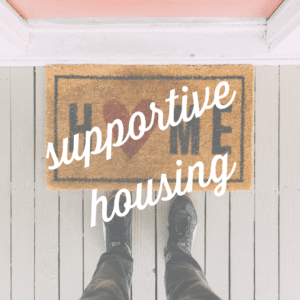
Supportive Housing is a type of program that addresses homelessness and individual barriers to remaining housed. It is considered a best practice in the social services field.
Home. It means something different for each of us. For you it might mean a place to keep your plants, your books, and your boho macrame collection. For me, it could mean lots of natural light, cozy Facebook Marketplace furniture finds, and a home office with a Mt. Currie Special dog friend by my side.
Whatever your dream home looks like, it is most likely going to be safe, stable, and within reach (price and location notwithstanding). However for many British Columbians, it is getting more and more difficult to find and keep a safe, stable home.
Leaving aside the astronomical costs of living in some parts of our province, there are thousands of people who come up against other persistent barriers to finding and maintaining a home. Supportive housing is a means of combating this, so that as many people facing barriers as possible can not only find good homes, but can also become successful homeowners, residents, and tenants in the long-term.
What is supportive housing?
Supportive housing can refer to many different things, depending on where it is and who is describing it. But in general, supportive housing is a type of program that offers subsidized housing with on-site support and connections to outreach support services.
These programs are founded on the universal truth that safe housing is a determining factor in an individual’s overall success and health. Its holistic approach has been recognized in social services as best practice for individuals with barriers to housing. And now with COVID-19, it has been validated as one of the better options for keeping British Columbians housed and safe.
Supportive housing programs are meant for individuals or families who are experiencing barriers to housing, and are therefore at risk of or already experiencing homelessness. Supportive housing not only lowers those barriers, but also lowers the barriers to accessing support for issues that would keep someone from being housed long-term.
As for what kinds of barriers will be addressed through these programs, they will be as diverse and individual as the people who need them. Supportive housing can encompass any number of life skills supports, disability supports, mental health supports, family supports, addictions supports, legal supports, financial supports and more. It is highly individualized, so the exact support structure and resources needed will differ from case to case.
Typically, a person or family who is facing homelessness will make an application to a supportive housing program. A support worker will work with them to identify and address their individual needs and goals. Once they are homed, the support will continue, and they might be connected to additional outreach services in the area. Some programs have in-house teams who take care of the support services for the residents.
How is supportive housing effective?
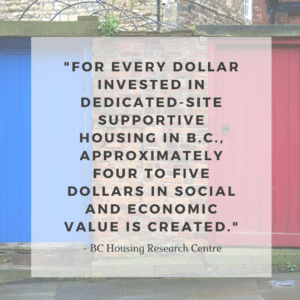
Supportive housing can be much less costly than other housing programs for people experiencing homelessness and barriers to housing, and it can even add value to our economy and communities.
Supportive housing is considered an effective response to issues of homelessness or precarious housing.
It is relatively low-cost. In a study across different American cities, supportive housing was found to be no more costly—and at times even much less costly—than other programs serving people experiencing homelessness. These alternatives (shelters, jails, prisons, hospitals, or mental health facilities) tend to be publicly funded, short-term solutions that can be very expensive to run and come with even greater cost to the individual. Supportive housing, on the other hand, can give far greater return on the dollar than these other alternatives. According to a 2018 report by BC Housing in 2018, “for every dollar invested in dedicated-site supportive housing in B.C., approximately four to five dollars in social and economic value is created.”
It is a long-term solution for what can be a short-term problem, given the right intervention. The crisis response-style of managing homelessness isn’t working. Hospitals, shelters, jails, prisons, and mental health facilities are usually overcrowded and understaffed, so aren’t always in a position to give individualized care to those who need it. These responses have been criticized for treating the symptoms of homelessness, and sometimes even putting people in unsafe situations because there is nowhere else for them to go. Supportive housing is not crisis intervention, it is proactive harm reduction.
It is generally available for the long term. For many programs serving vulnerable populations, the need often outweighs the capacity to serve them. There may be time limits for how long someone can access various supports, and the criteria for whether a person is cut off from support might be measured in a number of ways that the individual has little control of. Supportive housing best practices suggest there are no time limits for residents. For those that do limit the length of the program, the maximum residency term is usually twelve months or longer, with complementary programs to assist in transitioning residents out of it. In BC Housing-led programs, the limits are 2-3 years.
Support services are resident-led. Each person will work with a support team to determine what kinds of services they need to access within and beyond the program. That could mean a greater chance of successfully breaking the cycle of persistent homelessness. Individualized support is critical in ensuring that vulnerable people and families receive what they need in order to overcome barriers and go on to successful independent housing. Rather than being prescriptive, supportive housing empowers residents to get back on their feet and gives them the tools to move forward.
Supportive housing and Zero Ceiling
Did you know that we run a supportive housing program for our Work 2 Live crew?
We provide housing for at least 12 months for our participants, who all identify as youth aged 19-24, who have experienced homelessness or are at risk of homelessness. It is common that a crew member will have faced barriers and traumas that make it difficult for them to find and keep stable housing.
Every participant automatically receives a place to live that comes with individualized, wrap-around support and a job. Housing support is available to them for as long as they are in the program, and after graduation.
The supports we give include, but are not limited to:
- Individualized care
- Access to our Zero Ceiling Case Worker
- Help with goal setting
- One-on-one coaching and skills development
- Group coaching and skills development
- Life skills education (including modules on healthy housing and the RentSmart Certificate program)
- Access to outreach services (counselling, addictions support, legal aid, etc.)
- Access to The Friendly Landlord Network, a service that assists vulnerable youth transitioning to independent living to find and maintain private market housing with friendly landlords who are open to working with them
Supportive housing in BC
Our provincial government also believes that supportive housing is the best response to homelessness. BC Housing offers many programs and services for individuals facing homelessness. They have also prioritized more affordable housing and prevention measures to improve life for British Columbians with barriers. The province has also committed to helping supportive housing providers expand their ability to respond.
Many of those organizations have understood the potential of supportive housing, and have been offering these programs for the people they serve for years. We have been honoured to work with and learn from some of the best in the field, and are excited to see supportive housing projects making their way to the Sea to Sky community.
- Covenant House’s Rights of Passage program
- Aunt Leah’s Place
- Under One Roof (coming soon to Squamish!)
Supportive housing in the time of COVID-19
In June 2019, Canada adopted the National Housing Act into legislation, making housing a legal right. We joined a small handful of nations, as well as the UN, in recognizing a person’s economic, social and cultural right to adequate housing and shelter. As we wait to see what this means for the hundreds of thousands of Canadians in need of a safe place to live, supportive housing programs have needed to expand to meet the growing needs for people with barriers to housing.
Despite the ongoing global pandemic, we are as committed as ever to providing supportive housing for our participants and graduates. COVID-19 has highlighted the critical importance of supportive housing for individuals experiencing homelessness, and we are exploring ways to expand and enhance our housing options to keep young people safe during this time.
One of the ways we are doing this is through our partnership with The Friendly Landlord Network. They are a non-profit based in Metro-Vancouver that works to house youth leaving government care or some sort of supportive program, like ours. They find landlords who have space to rent and a social conscience; these landlords want to help a young person land on their feet by offering them a safe, stable home at an affordable rate.
While times are tough for businesses, renters, and landlords alike, we are encouraged by the recent discourse around supportive housing that has arisen from the need for social and physical distancing. Now that people understand how vital healthy housing is for overall success, we are seeing more funding and programs in place to sustain it for people affected by the pandemic. It begs the question: why has it taken so long for governments and funders to prioritize supportive housing when we knew it worked all along? Here’s hoping this lesson isn’t forgotten anytime soon.

